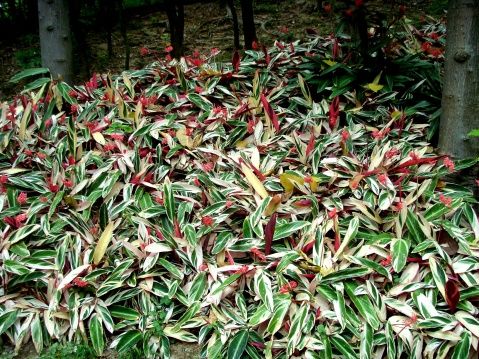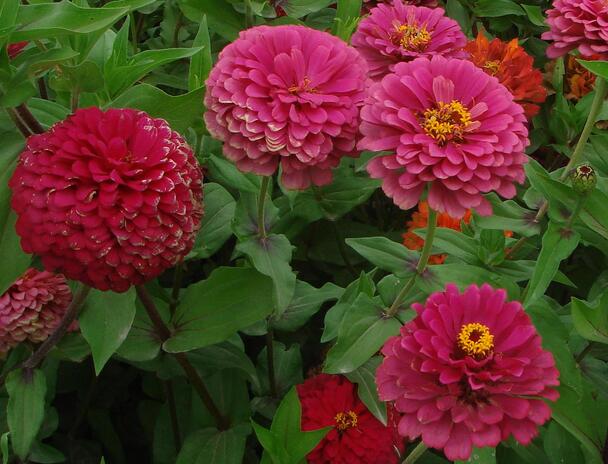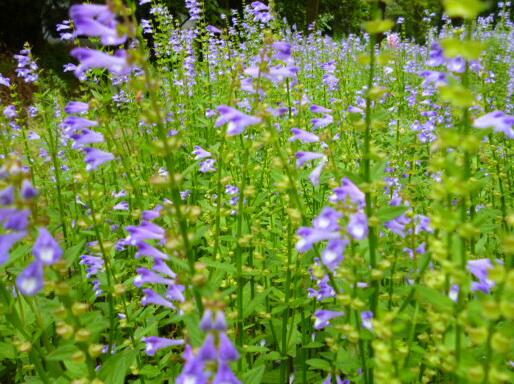How to propagate ramet propagation and cuttage propagation of purple back taro
Purple back taro likes warm, humid and shady environment. The suitable temperature for growth is 20-30 ℃, which needs more water and is not resistant to drought. More heat-resistant, slightly cold-resistant, more than 5 ℃ can safely pass the winter. Afraid of frost, like loose, fertile, moist and well-drained acid soil. How do you reproduce the purple back taro?

How to propagate Amorphophallus sinensis: propagation of individual plants
With the growth of purple back taro, the plant is getting bigger and bigger. If the growth is exuberant, the pot will be changed every 1-2 years. Therefore, it can be combined with changing pots for ramet propagation. When the temperature picks up in spring, ramets can be carried out throughout the year if the temperature and humidity are suitable.
Remove the plant of the purple back taro to the pot and soil, and cut the clump of plants along the growth direction of the underground rhizome with a knife, preferably with stems and leaves or leaf buds. It can be divided into several clusters and then planted in pots. The planted taro was preserved in a shady place to control moisture, and the water could not be watered until normal growth was restored.
How to propagate purple-backed taro: cuttage propagation
The purple-backed taro is also often propagated by cutting. In general, the cutting propagation of purple back taro can be carried out at any time when the temperature is not lower than 20 ℃.
Purple back taro cuttings are generally propagated with top shoots, which are 10-15 cm long and cut off. To observe the size of the leaves, it is generally necessary to keep the leaves 1/3 or 1/2, treat the cuttings, put them in a cool place to allow the wound to heal, or use a little rooting powder to speed up rooting.
After the cuttings of Amorphophallus angustifolia were treated, the cuttings were inserted on the seedling bed, and the plant spacing was 5 × 10 cm. The seedbed can be made of breathable soil mixed with less organic matrix, such as river sand, vermiculite or perlite, and the soil should be disinfected before insertion. After cutting, 60% of the sunshade net should be covered to maintain the appropriate temperature and air humidity, and its management method is the same as ramet propagation.
Purple back taro generally takes root 30-50 days after cutting, but the survival rate of cutting is not as high as ramet propagation, generally about 50%.
How to raise purple back taro? how to propagate purple back taro?
Purple-backed bamboo taro has plump plant shape, luxuriant branches and leaves and beautiful leaf color, so it is of high ornamental value and is a good indoor foliage plant. Next, I will tell you how to raise and reproduce the purple-backed taro.
How to raise the purple back taro?
1. Temperature
Amorphophallus mandshurica is native to tropical and subtropical regions, and likes high temperature, humidity and semi-shade environment. The suitable growth temperature is 20-30 ℃, the best growth temperature is 18-21 ℃ in daytime, 16-18 ℃ at night, and the safe overwintering temperature is 10 ℃. Therefore, in summer to prevent high temperature exposure, put it in a cool place; winter should pay attention to cold, plants can be moved to a windless, warmer indoor winter.
2. Lighting
Avoid direct sunlight and grow better under indirect radiation or scattered light. Especially in summer, direct sunlight can easily cause leaf burns. If leaf burns are found, they should be moved immediately to places without direct light or shaded facilities or in the shade of trees, and the burned leaves should be cut off to prevent other pathogenic bacteria from invading from the wound. At the same time, the management of water and fertilizer should be strengthened to promote its re-distribution of leaves and restore its new appearance.
3. Moisture
The peak growing season is from March to October every year, and the most suitable air relative humidity for its growth is 75% 85%. The high air humidity is beneficial to the development of leaves. Especially during the period of new leaf extraction, if it is too dry, the leaf edge and tip of the new leaf are easy to wither and become deformed later. The leaves could not recover after wilting. Therefore, it is necessary to water frequently in the growing season, and often spray to the leaf surface, 3-4 times a day in summer, and in time, the best watering method is to spray foliar surface in the morning, soil surface at noon or afternoon, and whole plant irrigation in the evening, but pay attention to the soil not to be too sticky and too wet, otherwise it is easy to rot roots and cause diseases. After entering autumn and winter, the growth of purple back taro slows down, and the amount of water should be reduced gradually. According to the weather change, it can be decided to water once a day or once every 2-3 days, especially when the temperature is low, the soil should be kept dry to avoid cold damage.
4. Soil
The soil is required to be fertile, loose and well drained, and soil consolidation and stagnant water are avoided. Fertile humus and porous coarse media are often used as substrates. It is generally mixed with rotten leaf soil and peat soil; it can also be mixed with pond mud, peat and perlite at the ratio of 2:3:1; or it can be made by adding loose rotten leaf soil rich in organic matter plus 1 inch 3 perlite, plus a small amount of base fertilizer.
5. Fertilization
According to the principle of "frequent application and light application", the mixture of peanut bran and compound fertilizer or mature compost should be applied every two weeks in the peak growing season. The nutrient composition of fertilizer should be mainly nitrogen fertilizer, followed by phosphorus and potassium fertilizer. As the purple back taro is a foliage plant, the proper application of nitrogen fertilizer can make the leaf color more beautiful. In addition, 0.1% solution can be prepared with urea with 46% nitrogen content, and 0.2% solution containing more than 50% phosphorus and 30% potassium dihydrogen phosphate can be used as extra-root topdressing, and the effect is better when the dew is not dry in the morning or in the evening. When spraying, use a fine hole sprayer to spray both the positive and negative sides of the blade, spray once a week, spray 3 times in a row, then stop once, and then spray continuously. It should be noted that the concentration of fertilization should not be too high, otherwise it is easy to cause leaf burns to cause fertilizer damage, and even cause plant death in serious cases. Stop fertilizing during dormancy in winter and when it is too hot in summer.
How to propagate the purple back taro
I. ramets
Amorphophallus angustifolia is generally propagated separately, and the propagation is the best when the temperature is about 20 ℃ in spring, but it can also be carried out throughout the year as long as the temperature and humidity are suitable. When propagating, use a sharp knife to cut the root mass with stem leaves or leaf buds; a small amount of propagation can put the cut root mass with stem leaves and leaf buds directly in the mud basin; when propagating in large quantities, it should be placed on the seedbed; when the temperature and humidity do not meet the requirements, the film should be covered with a film; be sure to make the temperature in the film reach 20-28 ℃, humidity more than 80%.
Second, cuttage
Cutting propagation generally uses top shoots, cuttings are 10-15 cm long, leaves are retained 1/3 or 1/2 depending on leaf size, cuttings are treated with 500ppm's NAA for 2-3 seconds, and can also be treated with indole acetic acid, indole butyric acid and ABT rooting powder. After the cuttings were treated, they were inserted into the seedling bed with a row spacing of 5 × 10 cm. It is covered with thin film bow shed, and the management method is the same as ramet propagation. Cutting propagation can be carried out at any time when the temperature is not lower than 20 ℃. Cuttings take root in 30-50 days, but the survival rate of cuttings is not as high as that of ramet propagation; it is generally about 50%.
The above is for you to introduce the breeding and breeding methods of purple back taro, I hope it can help you, more household knowledge please pay attention.
The culture method of purple-backed taro how to propagate
The leaves of purple-backed taro are still very good-looking, so many people will plan to get one of these potted plants and worry about their own breeding techniques, so they have a comprehensive understanding of the cultivation method of purple-backed taro, so I will explain it to you below. in addition, there is also the method of reproduction of purple-backed taro to share with you, let yourself do a few pots, put it in a different place or a place, happy.
The culture method of purple back taro:
1. Soil: purple-backed taro likes loose, fertile, moist and well-drained acid soil. Pot cultivation can use rotten leaf soil, garden soil and river sand as the same amount of mixed soil and a small amount of base fertilizer as culture soil, which requires that the soil is nutritious, loose and ventilated.
2. Watering: the purple back bamboo taro is not resistant to drought, so it is necessary to give sufficient moisture in the growing season, keep the basin soil moist frequently, and pay attention to spraying water to the leaves, especially when the temperature is high and the air is dry in summer and autumn. to maintain high air humidity. However, attention should not be paid to the accumulation of water in the basin soil, so as not to affect the ventilation of the roots, resulting in poor growth or rotten roots; the temperature is relatively low after the end of autumn, so it is necessary to control the amount of watering and keep the basin soil slightly wet.
3, lighting: purple back taro like shade, avoid direct sunlight, do not put in the sun, otherwise the leaves fade green, lose luster, serious sunburn will cause; but also should not be placed in the dark and poor ventilation for a long time, so as to avoid leaves yellowing and falling off.
4. Fertilization: in the growing season, liquid fertilizer is applied twice a month to ensure its robust growth and luxuriant branches and leaves.
5. Insect diseases: the common diseases of purple back taro are leaf spot and leaf blight. At the initial stage of the disease, 200 times Bordeaux solution was sprayed 2-3 times every half month. It can also be sprayed with 600 times solution of 65% Dysen zinc wettable powder. The common insect pests are mainly shell insects, which are easy to occur when the ventilation is poor. Spray with 1000 times of 50% fenitrothion EC in the nymph stage.
Culture method of purple back taro (basic knowledge):
The best propagation time: the separation of purple back bamboo taro should be carried out after the temperature warms up in spring.
The best growing soil: purple back taro prefers loose, fertile, moist and well-drained acidic soil.
Growth humidity requirements: the air relative humidity most suitable for its growth is 75% 85%, and the high air humidity is beneficial to the development of leaves.
The optimum growth temperature of Amorphophallus sinensis is 20-30 ℃.
The best growth light: purple back taro likes shade, avoid direct sunlight, can not be placed in the sun, otherwise the leaves fade green, lose luster, serious will cause sunburn; but should not be placed in the dark and poor ventilation for a long time, so as to avoid leaves yellowing and shedding.
How to propagate purple-backed bamboo taro-ramet propagation
With the growth of purple back taro, the plant is getting bigger and bigger. If the growth is exuberant, the pot will be changed every 1-2 years. Therefore, it can be combined with changing pots for ramet propagation. When the temperature picks up in spring, ramets can be carried out throughout the year if the temperature and humidity are suitable.
Remove the plant of the purple back taro to the pot and soil, and cut the clump of plants along the growth direction of the underground rhizome with a knife, preferably with stems and leaves or leaf buds. It can be divided into several clusters and then planted in pots. The planted taro was preserved in a shady place to control moisture, and the water could not be watered until normal growth was restored.
How to propagate purple back bamboo taro-cuttage propagation
The purple-backed taro is also often propagated by cutting. In general, the cutting propagation of purple back taro can be carried out at any time when the temperature is not lower than 20 ℃.
Purple back taro cuttings are generally propagated with top shoots, which are 10-15 cm long and cut off. To observe the size of the leaves, it is generally necessary to keep the leaves 1/3 or 1/2, treat the cuttings, put them in a cool place to allow the wound to heal, or use a little rooting powder to speed up rooting.
After the cuttings of Amorphophallus angustifolia were treated, the cuttings were inserted on the seedling bed, and the plant spacing was 5 × 10 cm. The seedbed can be made of breathable soil mixed with less organic matrix, such as river sand, vermiculite or perlite, and the soil should be disinfected before insertion. After cutting, 60% of the sunshade net should be covered to maintain the appropriate temperature and air humidity, and its management method is the same as ramet propagation.
Purple back taro generally takes root 30-50 days after cutting, but the survival rate of cutting is not as high as ramet propagation, generally about 50%.
- Prev

Propagation, cultivation, maintenance and management of zinnia
Hundred-day grass likes warmth, cold tolerance, sunshine, fear of heat, strong sex, drought tolerance, barren resistance, and avoid continuous cropping. The root is deep and the stem is hard and not easy to lodge. It is suitable to grow in fertile and deep soil. The suitable temperature during the growing period is 15-30C. The following editor brings you the methods of propagation, cultivation, maintenance and management of zinnia.
- Next

The Propagation method of Scutellaria barbata
The half-branch lotus plant can be up to 55 cm high, with dense clusters, colorful flowers and long flowering period. it is an excellent combination of flowers for decorating grasslands, slopes and roadsides. It is also suitable for planting at the edge of flower beds and flower borders. Potted plants are small and exquisite, and can be displayed in balconies, windowsills, corridors, doors, poolsides and courtyards.
Related
- Fuxing push coffee new agricultural production and marketing class: lack of small-scale processing plants
- Jujube rice field leisure farm deep ploughing Yilan for five years to create a space for organic food and play
- Nongyu Farm-A trial of organic papaya for brave women with advanced technology
- Four points for attention in the prevention and control of diseases and insect pests of edible fungi
- How to add nutrient solution to Edible Fungi
- Is there any good way to control edible fungus mites?
- Open Inoculation Technology of Edible Fungi
- Is there any clever way to use fertilizer for edible fungus in winter?
- What agents are used to kill the pathogens of edible fungi in the mushroom shed?
- Rapid drying of Edible Fungi

